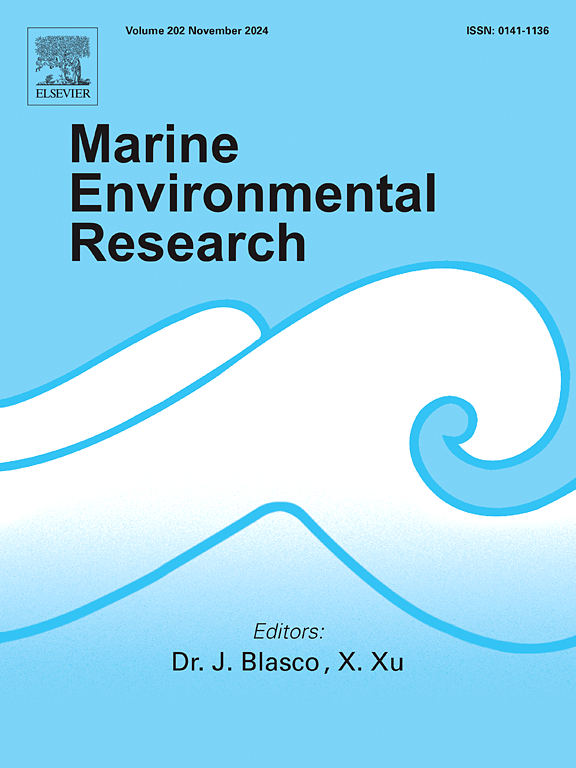What can go wrong for future Senegalese sole recruitment? Temperature and food availability as important drivers of early-life-history traits
IF 3
3区 环境科学与生态学
Q2 ENVIRONMENTAL SCIENCES
引用次数: 0
Abstract
Water temperature and prey availability are key factors influencing the successful recruitment of early life stages in fish. Understanding how these variables modulate larval growth and survival is essential for modelling larval dynamics. In this study we reared S. senegalensis larvae under controlled laboratory conditions to assess the effects of temperature and feeding frequency on larval development. Three temperatures (17, 20, and 23 °C) and three feeding frequencies (Ff 2.5 fed 2.5 times per week, Ff 4 four times per week, and Ff 6 six times per week) were tested from 12 to 32 days post-hatch (dph) in both individual and group housing systems. Survival, growth, and metamorphosis progress were monitored, and the expression of six genes related to nutrition (tryp1a and apoA4Aa2), cellular stress (hsp90aa and hsp70), endocrine regulation (tgb), and muscle development (myf4) were monitored on S3 and S4 metamorphic larvae. The feeding frequency appeared as the primary driver influencing all investigated traits, while temperature played a less pronounced effect. These data demonstrate the critical role of energy provision in regulating growth, development, and survival, which interacts with temperature, particularly under conditions where metabolic and energy demands cannot be fully fulfilled. Additionally, the Senegalese sole larvae exhibited compensatory genomic adaptive responses to efficiently mobilize nutrients from the gut and adjust the thyroid axis and cellular responses to support metamorphosis transformation and metabolism when food availability was limited or when temperature approached physiological thresholds.
未来塞内加尔人的独家招聘会出现什么问题?温度和食物供应是早期生活史特征的重要驱动因素
水温和猎物的可用性是影响鱼类早期生命阶段成功招募的关键因素。了解这些变量如何调节幼虫的生长和存活是模拟幼虫动力学的必要条件。本研究在实验室控制条件下饲养塞内加尔沙蚕幼虫,研究温度和取食频率对其发育的影响。在孵化后12 ~ 32天,分别在个体和群体饲养系统中测试三种温度(17、20和23℃)和三种摄食频率(Ff 2.5每周摄食2.5次,Ff 4每周摄食4次,Ff 6每周摄食6次)。监测S3和S4变质幼虫的生存、生长和变态进展,并监测6个与营养(tryp1a和apoA4Aa2)、细胞应激(hsp90aa和hsp70)、内分泌调节(tgb)和肌肉发育(myf4)相关的基因的表达。取食频率是影响各性状的主要因素,而温度的影响不明显。这些数据表明,能量供应在调节生长、发育和生存中的关键作用,与温度相互作用,特别是在代谢和能量需求不能完全满足的条件下。此外,当食物供应有限或温度接近生理阈值时,塞内加尔比目鱼幼虫表现出代偿性基因组适应反应,有效地从肠道调动营养,调节甲状腺轴和细胞反应,以支持变态转化和代谢。
本文章由计算机程序翻译,如有差异,请以英文原文为准。
求助全文
约1分钟内获得全文
求助全文
来源期刊

Marine environmental research
环境科学-毒理学
CiteScore
5.90
自引率
3.00%
发文量
217
审稿时长
46 days
期刊介绍:
Marine Environmental Research publishes original research papers on chemical, physical, and biological interactions in the oceans and coastal waters. The journal serves as a forum for new information on biology, chemistry, and toxicology and syntheses that advance understanding of marine environmental processes.
Submission of multidisciplinary studies is encouraged. Studies that utilize experimental approaches to clarify the roles of anthropogenic and natural causes of changes in marine ecosystems are especially welcome, as are those studies that represent new developments of a theoretical or conceptual aspect of marine science. All papers published in this journal are reviewed by qualified peers prior to acceptance and publication. Examples of topics considered to be appropriate for the journal include, but are not limited to, the following:
– The extent, persistence, and consequences of change and the recovery from such change in natural marine systems
– The biochemical, physiological, and ecological consequences of contaminants to marine organisms and ecosystems
– The biogeochemistry of naturally occurring and anthropogenic substances
– Models that describe and predict the above processes
– Monitoring studies, to the extent that their results provide new information on functional processes
– Methodological papers describing improved quantitative techniques for the marine sciences.
 求助内容:
求助内容: 应助结果提醒方式:
应助结果提醒方式:


